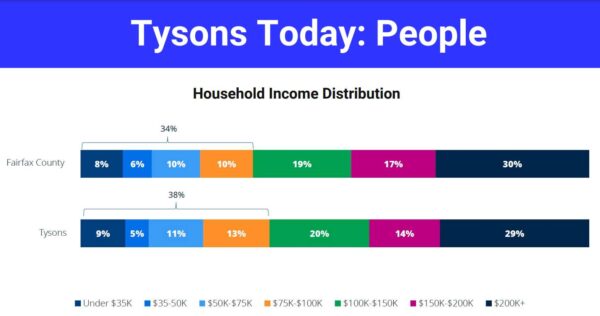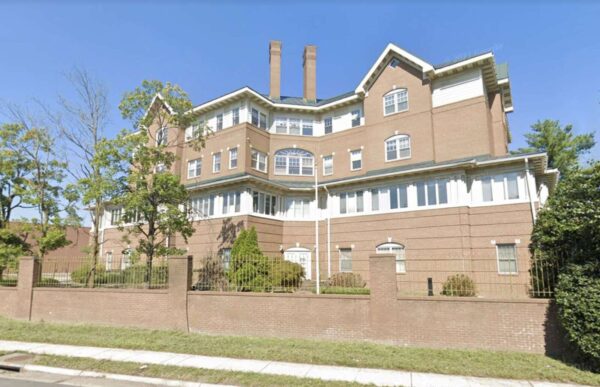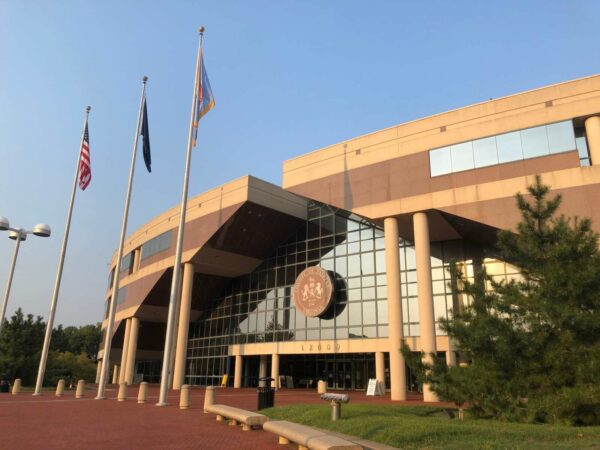
After introducing itself earlier this year with a website update and some cherry blossom-related events, the Tysons Community Alliance is now digging into the area’s strengths, needs and what needs to be done to set it up for future success.
Picking up where the now-defunct Tysons Partnership left off, the nonprofit community improvement organization launched a strategic planning effort for Tysons this week by convening a series of work groups that will focus on different topics, such as residential development, transportation and parks.
The strategic plan will serve as an update on the current state of Tysons and a guide to implementing Fairfax County’s Tysons Comprehensive Plan, TCA Board of Directors Chair Josh White told the Board of Supervisors at an economic initiatives committee meeting on June 13.
“One of the key purposes of the alliance is to help catalyze the continuing transformation of Tysons into a walkable, urban center and community,” White said. “…It is our intent to facilitate a community engagement process with a lens focused on diversity, inclusion, equity, and sustainability, which will chart a future direction for Tysons and help shape an action agenda.”
As part of the planning process, the TCA is conducting a conditions assessment and market study that will provide data on economic trends and gaps to support the future strategic plan as well as a new Tysons database.
Acting TCA CEO Richard Bradley — who will soon give way to the first permanent CEO, Katie Cristol — described the database as a more comprehensive version of the Tysons Tracker that the county launched in 2021, sharing information about all things Tysons, from population data to office usage.
Underway since April, the market study is slated to be finished around mid-July, per the presentation. But statistics shared by TCA leaders reinforced the oft-repeated refrain that Tysons is the county’s “economic engine,” while also exposing potential challenges to its ambitions.
Despite encompassing just 1% of the county’s total land area, Tysons accounts for 17% of its jobs, 10% of all retail revenue and 8% of tax revenues, White touted.
As reported to the Fairfax County Planning Commission in January, about 30,124 people now live in Tysons — a 96% increase from 2010, when the comprehensive plan was adopted. Like the county as a whole, the area has a “minority-majority” population, and while 29% of residents earn salaries of $200,000 or more, 38% have incomes of $100,000 or under — a larger percentage than in the overall county.

Some supervisors expressed surprise at those numbers, noting that affordable housing will be critical for maintaining the area’s “economic diversity.”
“I think we all hear Tysons or we hear McLean or we hear Oakton or we hear Falls Church or Alexandria, and we have these preconceived notions of who lives there and what does the community look like and what do the businesses look like,” Providence District Supervisor Dalia Palchik said. Read More

A new drug treatment center could revive a building that has been vacant for more than two decades on Lorton Road.
The Florida-based company Praesum Healthcare Services is seeking Fairfax County’s approval to repurpose the building at 7665 Lorton Road with a medical care facility for inpatient alcohol and addiction treatment and services.
Opioids are the number one cause of unnatural death in Fairfax County, according to the Fairfax-Falls Church Community Services Board. Like elsewhere in the country, people between the ages of 25 and 34 have been hit harder by drug abuse than any other age group.
Although the county’s zoning allows for up to 67 beds, Praesum plans to offer up to 40 beds in the facility, which is off Richmond Highway near Gunston Plaza shopping center. The company says revitalizing the site will require “significant investment to make it operational again.”
The existing two-story building has been vacant for more than 20 years, according to the application. It was most recently used for assisted living and memory care housing.
“This application seeks to provide a much needed service in our community simply by changing the type of care provided under the same use that was previously approved within the existing structure,” a Feb. 7 statement of justification submitted by Praesum says.
Praesum says it hopes individuals struggling with substance abuse will learn to “develop healthy coping skills to deal with stress, triggers and anxiety.” The company did not return requests for comment from FFXnow.
The company has 28 similar facilities throughout the country. The Lorton site is expected to have 15 parking spaces.
In recent years, the county has amped up efforts to address drug abuse.
The Countywide Strategic Plan, a key guiding document for the county that was adopted last year, highlights the need to remove barriers to ensure the equitable access for individuals seeking treatment for substance abuse.
The county’s Opioid and Substance Use Task Force identified a two-pronged approach for fiscal years 2021 and 2022: reducing deaths through prevention and treatment, and using data to describe the problem and evaluate effectiveness.
Praesum’s case is under review by staff. Public hearing dates have not yet been set on the county’s land use docket.
Photo via Google Maps
Fairfax County officially has its first countywide strategic plan.
The Board of Supervisors voted 9-1 yesterday (Tuesday) to adopt the document, which presents an all-encompassing, coordinated vision for the county’s operations, priorities, and services over the next two decades.
In the works since 2019, the strategic plan focuses on 10 “community outcome areas” that “represent the issues of greatest importance” to the community:
- Cultural and recreational opportunities
- Economic opportunity
- Effective and efficient government
- Empowerment and support for residents facing vulnerability
- Health and environment
- Housing and neighborhood livability
- Lifelong education and learning
- Mobility and transportation
- Safety and security
“The Countywide Strategic Plan will help guide our future together so the Board, residents and staff are working toward the same goals and outcomes,” Board of Supervisors Chairman Jeff McKay said in a press release. “This plan will be a centralized, coordinated way for us to be even more efficient as a government so we’re more responsive to our community’s needs.”
The strategic plan was initially developed prior to the pandemic, but the county paused the process due to the public health emergency and reworked the plan to encompass new prioritizations from the last 18 months.
The main change was the separation of health and environment into two separate categories.
It’s intended to be a living document that integrates other broad planning efforts like the Fairfax County Public Schools’ strategic plan and the One Fairfax policy. It will also help the board focus its legislative efforts over the next several years.
In the press release, County Executive Bryan Hill called Fairfax County’s first-ever “unified” strategic plan “a key milestone” in the government’s efforts to shape the county’s future.
“I’m grateful to the tens of thousands of residents and hundreds of staff who have developed this plan,” Hill said. “I look forward to the next steps, including reporting results to the community, aligning existing plans within this framework and further advancing our One Fairfax equity lens across all outcome areas.”
At yesterday’s Board of Supervisors meeting, Springfield District Supervisor Pat Herrity was the only board member to vote against adopting the plan, citing insufficient community feedback.
He also argued that the plan should do more to address traffic congestion and that it will continue to allow taxes to be too high.
The other supervisors approved the strategic plan, despite several noting that they were not 100% pleased with the process and expressing concern that the document is too vague.
Dranesville District Supervisor John Foust criticized the lack of prioritization, information about implementation, or how the county is progressing based on over 150 metrics identified by the plan.
“I don’t think we are done, to say the least,” Foust said. “This is not, in my opinion, a roadmap for the county executive to prioritize and budget…We need to keep working, and the board has to stay involved to complete the process.”
Several supervisors observed that there was a lack of participation from a diverse set of voices.
As of September, the county had received nearly 22,000 survey responses in eight different languages. A fourth survey closed on Sept. 24, so that number will be updated later this month.
A feedback session held in July found that the attendees’ preferred focus areas were cultural and recreational opportunities, economic stability and mobility, financial sustainability and access to services.
Now that the plan has been adopted, the county will start implementing its guidelines, a process that will include further community engagement, prioritization, and identifying “headline metrics” in each of the 10 areas that will be used to develop the fiscal year 2024 budget.


